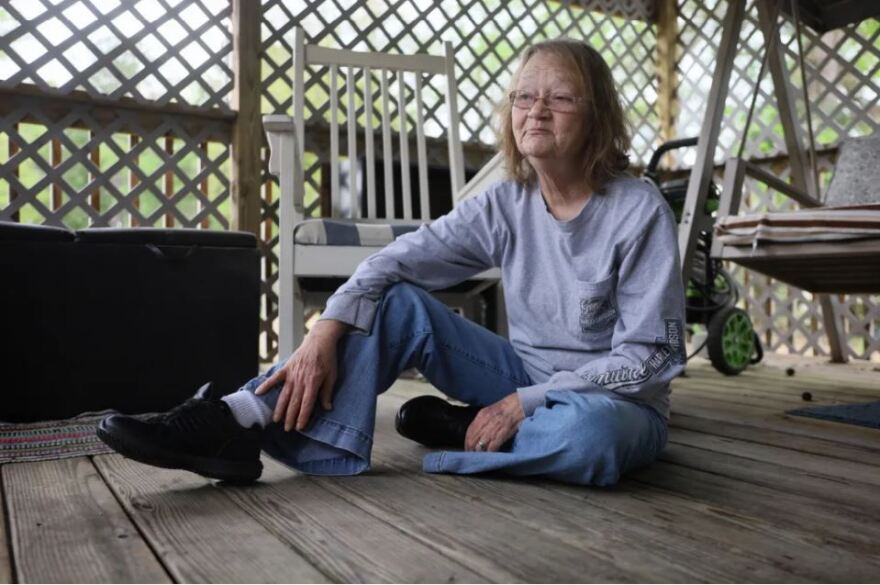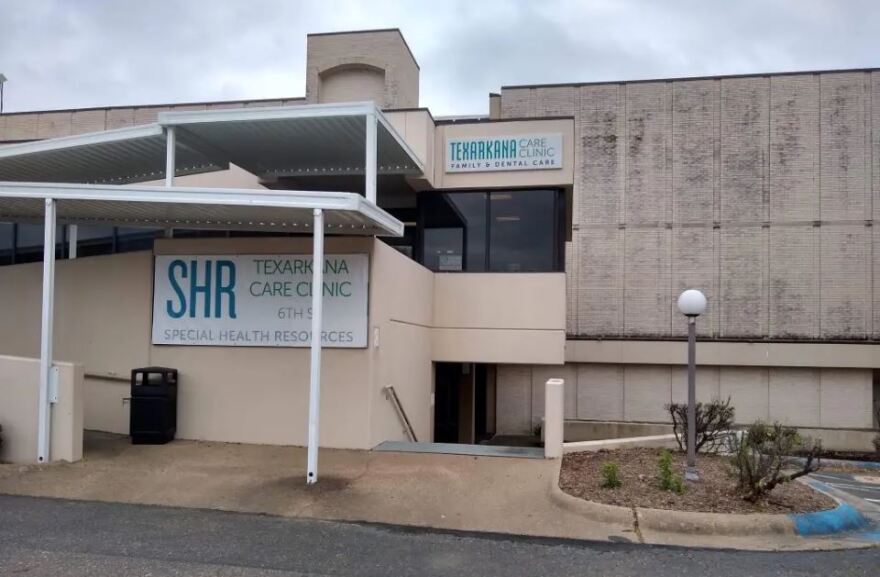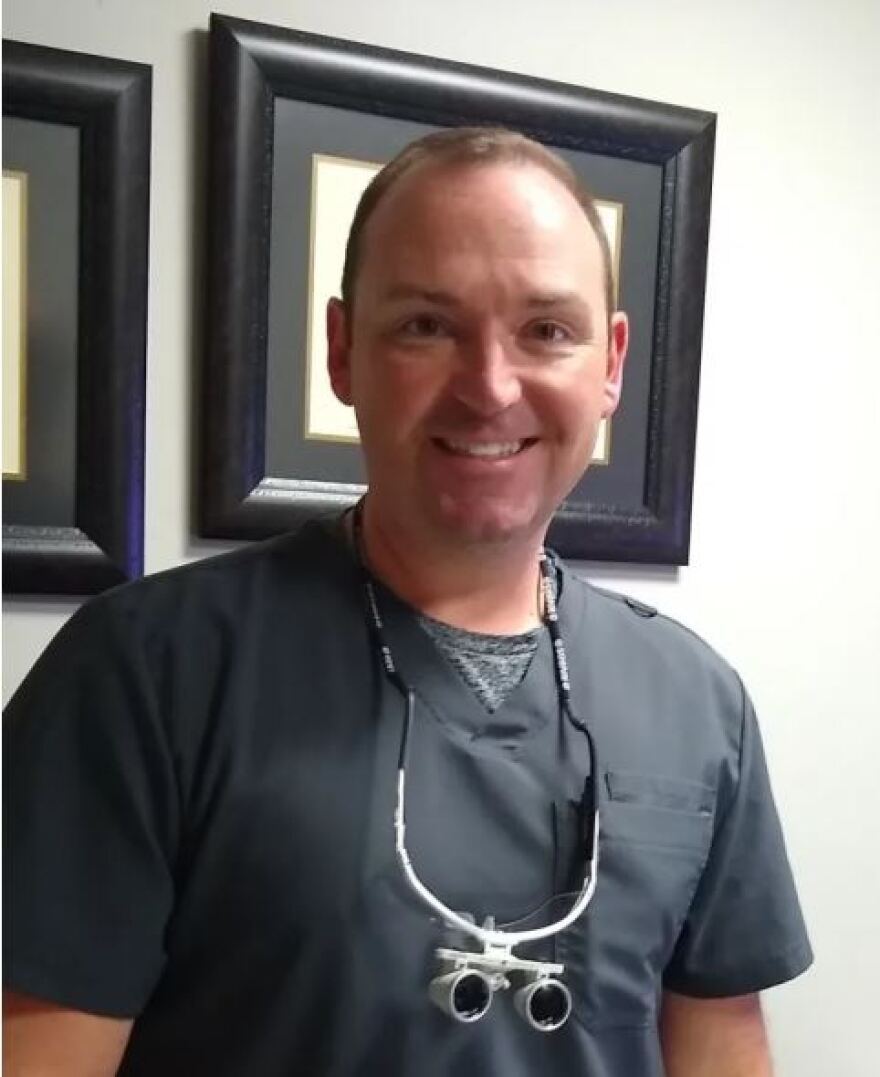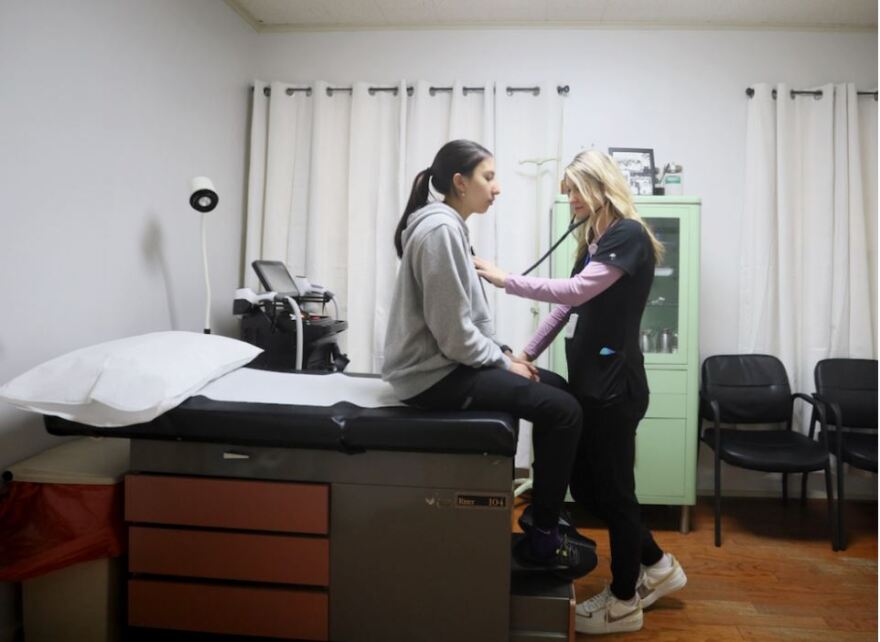Many people can survive a long stretch without seeing a doctor. Deborah Stoner doesn’t think she would make it.

Three years ago, Stoner, now 62, lost her husband’s health insurance after he retired and they relocated to the northeast corner of Texas to be near their grandchildren. She planned to find new coverage after settling down in the small city of Texarkana, but it was more difficult than she anticipated.
Every health plan she found was unaffordable on their fixed Social Security income. But she badly needed regular medical care. Stoner has peripheral vascular disease as well as high blood pressure and cholesterol. She takes six prescription drugs a day.
“It was extremely stressful,” she said. “I knew I needed to see a doctor. Sometimes I can hardly breathe.”
Like Stoner, more than 18% of Texarkana residents younger than 65 are living without health insurance, according to the latest U.S. Census Bureau data. That’s nearly double the national rate.
But the story is far different just a short drive away.

On the east side of State Line Avenue, which traces the state border through downtown, is Texarkana’s twin city – Texarkana, Arkansas. Cross the avenue and the local uninsured rate drops by more than six percentage points, to about 12%.
Other key aspects of the cities are nearly the same. The poverty rate is almost identical, at more than 21%. Employment rates and median household incomes are similar. Both cities are majority white, and more than a third of residents are Black and less than 10% are Hispanic.
In a crucial policy area, though, a sharp contrast stands out: Texarkana, Arkansas, has Medicaid expansion.
“It’s a tale of two cities — it truly is,” said Klark Kent, a physician associate at Texarkana Care Clinic, a safety-net clinic on the Texas side that serves patients from both states. “It’s a stark difference.”
When Medicaid expansion went into effect in 2014, the Texarkana area began drawing national attention. Because of a 2012 Supreme Court decision, states were allowed to accept or reject federal funds to expand Medicaid for low-income residents, and Arkansas took the offer. Texas refused – and still does. In a two-state border community, how would that difference play out over time?
More than nine years later, the answer is clearer:
- The Arkansas city’s uninsured rate for those under 65 fell by more than six percentage points, to 12.2%, from 2012-2016 to 2017-2021, according to Census Bureau estimates. On the Texas side, the rate dropped by more than four percentage points, to 18.5%. As a result, the gap between the cities’ rates widened. Adults without children in Arkansas can now enroll in Medicaid if they make $20,120 a year or less. In Texas, they’re ineligible.
- Differences in health outcomes are emerging. A study published in October found that admissions to Texarkana hospitals over eight years for a potentially fatal complication from uncontrolled diabetes – diabetic ketoacidosis – increased significantly more for patients from Texas than Arkansas. “The slope of increase was less for them [Arkansas patients], suggesting expansion helped people control their diabetes better,” said study co-author Meryem Saygili, an assistant professor of economics at the University of Texas at Tyler.
- Doctors, clinics, a hospital study and other providers say health-care access for low-income patients in Arkansas is better because of Medicaid expansion. But providers caution against oversimplifying the issue of lack of access to care. Other determining factors are low Medicaid reimbursement rates for providers in Texas, some doctors say, and shortages of primary care doctors and specialists in surrounding rural areas, especially in Arkansas.
- The two-state expansion divide is a major, unique challenge for hospitals, making patient admissions and Medicaid reimbursements more complicated, according to a 2020-2022 community health-needs assessment from Christus St. Michael Health System, one of the largest hospitals in Texarkana. One unnamed “stakeholder” told the study’s interviewers: “Texarkana is a city that is split between two health-care philosophies.”
On the Safety-Net Frontline
The Texarkana Care Clinic, where Kent sees patients, is a low-slung, red-brick building on the Texas side, just five blocks from State Line Avenue. He’s been at the clinic for three years and before then mostly worked in local emergency rooms and urgent care centers.

Kent said one reason he switched to the safety-net clinic was the unremitting stream of patients he saw in the emergency room who had no other place to go for regular, basic care.
Most of the clinic patients he sees are uninsured or have Medicaid coverage.
The clinic is part of Special Health Resources, a federally qualified health center with 10 sites in Texas and one in Arkansas. These centers are required to take anyone, regardless of their ability to pay.
Texarkana Care Clinic is where Deborah Stoner finally found the care she needed. She wasn’t eligible for Medicaid, and the federal marketplace was too costly. At the clinic, she pays on a sliding scale, only $38 every three months. Without such affordable access, she said, “I’d die.”
Kent said many of his patients suffer from complex, chronic illnesses, but connecting them with more specialized care — to a cardiologist or kidney expert, for example — is often more difficult when the patient lives in Texas. The clinic will make referrals to specialists or diagnostic centers for uninsured patients, but can’t guarantee the costs will be affordable.
“Being a border city, it’s easy to see the differences in continuity of care,” he said. “Those challenges are less on the Arkansas side.”

Comparing the Cities

Last year, Special Health Resources served about 3,500 patients combined at its two Texarkana clinics, said Chief Executive Officer Shaun’ta Whitehead. The clinic on the Texas side sees more uninsured patients; the clinic on the Arkansas side just east of the state line, has more with Medicaid coverage.

Even though Special Health Resources takes everyone, Whitehead said the lack of Medicaid expansion in Texas has a “huge impact” on patients who, in an expansion state, might have the coverage to afford higher levels of care.
“We don’t turn anyone away, but we’re limited in the types of services we can provide,” she said.
Joshua Talley, a dentist at Texarkana Care Clinic in Arkansas who sees mostly adults, reported a similar pattern of patients — most of his uninsured patients hail from Texas, and most Medicaid patients live in Arkansas.
On a typical day, the sliding-scale dental clinic sees about 25 patients, most of them for operative care such as being fitted with a dental crown or having teeth pulled. “The majority of my patients — you can take nine out of 10 adults — they’re going to need multiple tooth extractions,” Talley said. “That’s just pretty standard.”

National data show low-income or uninsured adults are three times as likely to have four or more untreated cavities than people with private insurance or higher incomes. Talley said patients with private insurance typically need a “fraction” of the care that self-pay and Medicaid patients do, probably because they have better access to preventive care.
“I can just look at X-rays and tell you who’s who,” he said.
Marsha Young credits Talley with bringing her mouth back to life. Young, 46, lives in Nash, Texas, a suburb of Texarkana, and is a single mom and full-time caregiver to two sons with special health-care issues, including cerebral palsy. Because of her caregiving status and extremely low income, Young was able to qualify for Texas Medicaid.

The coverage made a huge difference. About a year ago, her toothaches were so bad she was having trouble eating. At the clinic, Talley pulled the decaying teeth and fit her with two partial dentures. “It saved my life,” Young said.
Paying Providers
Talley’s dental clinic has stopped providing dentures and partials because it’s too expensive, he said. Instead, the clinic works with local dentists to find patients affordable access elsewhere. Out of pocket, dentures can cost thousands.
“You want to do the best for everybody,” Talley said, “but your hands are tied.”
Talley believes Medicaid expansion would help improve access, but he’s worried that low physician reimbursement rates under Texas Medicaid would still make it hard to find a provider. He said it’s not uncommon for patients to drive over an hour to see him because none of the dentists in their own communities take Texas Medicaid insurance.

Dr. Cindy Porter, who’s been seeing patients in Texarkana for nearly 30 years, has the same concerns. Porter is a pediatrician at Collom & Carney Clinic, a large private practice on the Texas side of Texarkana. Almost 12% of her overall practice is Medicaid patients; 39% of those are on Texas Medicaid.
For a typical visit, Texas Medicaid pays Porter about 38% of what a commercial insurer would pay and 84% of what Arkansas Medicaid pays. Meanwhile, she said, demand for doctors who take Medicaid insurance has only risen since COVID-19 arrived and Medicaid enrollments swelled.
An example of the demand: About four years ago, Porter opened her practice to new Texas Medicaid patients. About 1,000 families inquired within a month, some from as far away as San Antonio. She’s currently not taking new Medicaid patients.
Last summer, Porter got the chance to meet Texas Gov. Greg Abbott at a fundraiser. When she said she was a doctor, he thanked her for being on the front lines. She asked him to raise Medicaid rates.
“He smiled and he goes, ‘We’re working on it,’” Porter said. “And I said, ‘You need to fervently work on it.’”
State legislators haven’t passed an enduring, across-the-board increase in Texas Medicaid physician fee-for-service rates in two decades, according to the Texas Medical Association. A 2021 federal report found only 65% of Texas doctors were taking new Medicaid patients in 2017, down from 67% in 2013. That compared with almost 94% who were taking new privately insured patients.
“I don’t think we’ll see significant improvement in access if Medicaid rates are not increased at least to Medicare payment rates,” said Dr. Gary Floyd, a pediatrician and current president of the Texas Medical Association. “And that perhaps is not even adequate.”
The Live Well Texas plan, a bill introduced by Democrats in the Texas House and Senate this session, proposes not only to expand Medicaid but also to raise Medicaid physician reimbursement rates for serving the newly insured to parity with Medicare. If Medicaid were expanded, about 5,100 low-income residents in Bowie County, Texas, where Texarkana is located, would become eligible for health insurance, the Houston-based Episcopal Health Foundation estimates.
A Persistent Gap

Cortney White believes expansion has been a positive force for her patients. A sign at her clinic’s front desk reminds patients to check their mailboxes for Medicaid renewal forms, as states begin redetermining eligibility for millions who qualified during the nation’s COVID-19 emergency. More than 422,000 Arkansans, as well as 2.7 million Texans, will be impacted by the unwinding process.
But expansion hasn’t been a cure-all, White said.
In 2020, the nurse practitioner opened White’s Family Clinic in the small town of Ashdown, Arkansas, 20 miles north of Texarkana. White, 39, is the only health provider there and does a little bit of everything: chronic disease management, wellness checks, tattoo removals, stitches. She sees up to 35 patients a day, five days a week.
About 30% of her patients are uninsured. She said many of them have fallen into the same gap her own family has — ineligible for Arkansas Medicaid but unable to afford quality insurance on the marketplace.
Last year, her husband lost his job at Domtar, the local paper mill, and the health coverage that came with it. Now all the couple can afford for themselves and their three children is catastrophic health coverage. The deductible is too high to use it for regular care.
“I’m right there with them,” White said of her patients. “I understand how they feel.”
David Fritze contributed to this story.
Note: The Episcopal Health Foundation, mentioned in the story, has awarded grants to Public Health Watch.
This story is part of “The Holdouts,” a reporting collaborative focused on the 10 states that have yet to expand Medicaid, which the Affordable Care Act authorized in 2010. The collaborative is a project of Public Health Watch.


